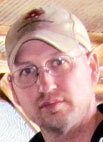
Floyd Renner met his future wife, Carrie, when his father was harvesting wheat on Carrie’s place. Though Floyd and Carrie went their separate ways, they eventually reconnected and now live in Fairview, Mo. Floyd left a dairy farm when he went on his honeymoon but returned to a cattle ranch when his father decided to get out of the dairy business. The couple has three children; Maci age 11, Marshall age 8 and Macelynn who is a little over a year old.
Floyd owns or rents 500 acres and has 80 Angus and Angus/Hereford cross cows with two Angus bulls. One is registered while the other is not which works well with his commercial herd. Floyd likes the combination because it provides hybrid vigor and produces black hides because of the bulls. In addition, he believes Herefords are more docile and feed efficient. He sells his calves at 750 pounds to 800 pounds and runs both spring and fall calves.
While Floyd vaccinates for blackleg, worms and respiratory issues, he also makes a point of vaccinating with tetanus.
One day, five years ago, he spied a tornado coming into Newtonia. He had just enough time to return to let the bulls out of a stock trailer and lead the calves in a holding pen into a field because lightning was popping all over the place. Floyd said, “The ground is still full of shrapnel, and the animals need the tetanus protection.” Fortunately Floyd lost no animals in the tornado, and a new storm shelter was built to replace an old and leaking one.
Floyd grinds some of his own feed according to what the animals need. He occasionally supplements with protein and explained, “I only supplement with protein when observations show me that the pastures and hay don’t appear to have enough protein.”
Floyd ran an experiment where he had one sheep per cow with the intent of the sheep eating the weeds so he would not have to spray the pastures as often. The experiment did not work because the sheep, though they did eat some of the weeds, liked the grass just as much as the cows. Further his vet believed the worms were transferable. The end result is that Floyd has a sheep herd as well as a cattle herd. He has 100 Katahdin and Katahdin/Dorper cross ewes. He sells his lambs in Diamond, Mo., but has changed the size of the lambs from 90 pounds to 70 pounds according to market demand.
A number of years ago, Floyd entered a cost-share government fencing/rotational grazing program. Two important results emerged from the program. One is use of a 30-acre cornfield for one week of grazing with the cattle grazing first followed by the sheep, which eat the little that is left. The pattern of grazing the cattle first is important so the sheep don’t founder from too much corn. The second result was gaining enough money from the fencing program to pay for the piping but not the trenching to new waterers fed from an old 220’ well and a one-year-old 240’ well. Floyd built the waterers himself for $125 apiece to ensure easy access for repairs.
The Renner operation also includes crop farming: corn, soybeans, barley and wheat. The crop farming is done in conjunction with his father, Murray, and brother, Jay, and is spread over 1,300 acres. Floyd remarked, “We crop farmland from Fairview to Jerico Springs, Mo., because finding good land to rent is difficult.” The no-till crop farming runs in a two-year cycle. Corn planting begins by April 1 and harvested September 15 at which time the cattle and sheep graze for a week. The land is then planted with barley or wheat which is harvested in June and followed by soybeans. After that, the two-year cycle begins again.Floyd explained, “It really makes sense to do both crops and livestock because typically when one goes down in price, the other goes up.”







